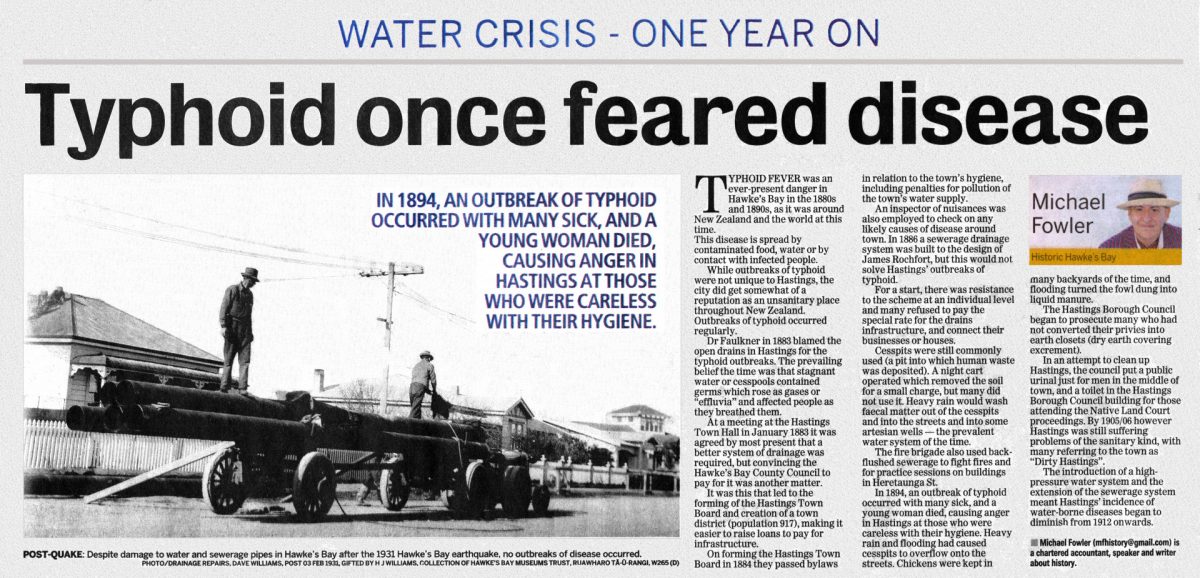WATER CRISIS – ONE YEAR ON
Typhoid once feared disease
Michael Fowler
Historic Hawke’s Bay
TYPHOID FEVER was an ever-present danger in Hawke’s Bay in the 1880s and 1890s, as it was around New Zealand and the world at this time.
This disease is spread by contaminated food, water or by contact with infected people.
While outbreaks of typhoid were not unique to Hastings, the city did get somewhat of a reputation as an unsanitary place throughout New Zealand. Outbreaks of typhoid occurred regularly.
Dr Faulkner in 1883 blamed the open drains in Hastings for the typhoid outbreaks. The prevailing belief [at] the time was that stagnant water or cesspools contained germs which rose as gases or “effluvia” and affected people as they breathed them.
At a meeting at the Hastings Town Hall in January 1883 it was agreed by most present that a better system of drainage was required, but convincing the Hawke’s Bay County Council to pay for it was another matter.
It was this that led to the forming of the Hastings Town Board and creation of a town district (population 917), making it easier to raise loans to pay for infrastructure.
On forming the Hastings Town Board in 1884 they passed bylaws in relation to the town’s hygiene, including penalties for pollution of the town’s water supply.
An inspector of nuisances was also employed to check on any likely causes of disease around town. In 1886 a sewerage drainage system was built to the design of James Rochfort, but this would not solve Hastings’ outbreaks of typhoid.
For a start, there was resistance to the scheme at an individual level and many refused to pay the special rate for the drains infrastructure, and connect their businesses or houses.
Cesspits were still commonly used (a pit into which human waste was deposited). A night cart operated which removed the soil for a small charge, but many did not use it. Heavy rain would wash faecal matter out of the cesspits and into the streets and into some artesian wells – the prevalent water system of the time.
The fire brigade also used back-flushed sewerage to fight fires and for practice sessions on buildings in Heretaunga St.
In 1894, an outbreak of typhoid occurred with many sick, and a young woman died, causing anger in Hastings at those who were careless with their hygiene. Heavy rain and flooding had caused cesspits to overflow onto the streets. Chickens were kept in many backyards of the time, and flooding turned the fowl dung into liquid manure.
The Hastings Borough Council began to prosecute many who had not converted their privies into earth closets (dry earth covering excrement).
In an attempt to clean up Hastings, the council put a public urinal just for men in the middle of town, and a toilet in the Hastings Borough Council building for those attending the Native Land Court proceedings. By 1905/06 however Hastings was still suffering problems of the sanitary kind, with many referring to the town as “Dirty Hastings”.
The introduction of a high-pressure water system and the extension of the sewerage system meant Hastings’ incidence of water-borne diseases began to diminish from 1912 onwards.
Michael Fowler ([email protected]) is a chartered accountant, speaker and writer about history.
Photo caption – IN 1894, AN OUTBREAK OF TYPHOID OCCURRED WITH MANY SICK, AND A YOUNG WOMAN DIED, CAUSING ANGER IN HASTINGS AT THOSE WHO WERE CARELESS WITH THEIR HYGIENE.
POST QUAKE: Despite damage to water and sewerage pipes in Hawke’s Bay after the 1931 Hawke’s Bay earthquake, no outbreaks of disease occurred.
PHOTO/DRAINAGE REPAIRS, DAVE WILLIAMS, POST 03 FEB 1931, GIFTED BY H J WILLIAMS, COLLECTION OF HAWKE’S BAY MUSEUM TRUST, RUAWHARO TA-U-RANGI, W265(D)












Do you know something about this record?
Please note we cannot verify the accuracy of any information posted by the community.